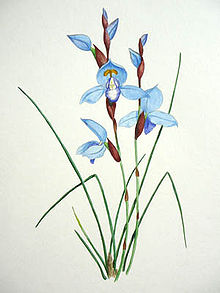
Sparaxis is a genus of flowering plants called the harlequin flowers. It belongs to the iris family Iridaceae with about 13 species endemic to Cape Province, South Africa.
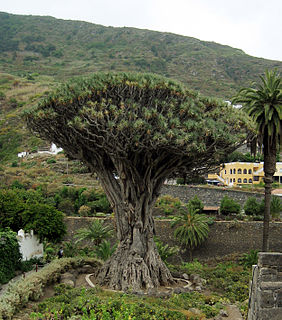
Dracaena is a genus of about 120 species of trees and succulent shrubs. The formerly accepted genera Pleomele and Sansevieria are now included in Dracaena. In the APG IV classification system, it is placed in the family Asparagaceae, subfamily Nolinoideae. It has also formerly been separated into the family Dracaenaceae or placed in the Agavaceae.

Inula is a genus of about 80 species of flowering plants in the family Asteraceae, native to Europe, Asia and Africa.

Ixia is a genus of cormous plants native to South Africa from the family Iridaceae. Some of them are known as the corn lily. Some distinctive traits include sword-like leaves and long wiry stems with star-shaped flowers. It usually prefers well-drained soil. The popular corn lily has specific, not very intense fragrance. It is often visited by many insects such as bees. The Ixia are also used sometimes as ornamental plants.

Watsonia is a genus of plants in the family Iridaceae, subfamily Crocoideae. Watsonias are native to southern Africa. The genus is named after Sir William Watson, an 18th-century British botanist.

Pancratium is a genus of African and Eurasian perennial, herbaceous and bulbous plants in the Amaryllis family, subfamily Amaryllidoideae
The Koninklijke Algemeene Vereniging voor Bloembollencultuur, translated from Dutch as the Royal General Association for Bulb Culture, but more commonly known world-wide by the acronym of KAVB, is a trade association for the bulb horticulture sector, and was established in 1860. The association has a rural organization, within which regional groups and departments are active.
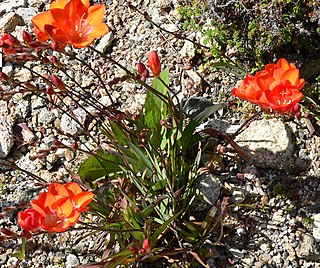
Tritonia is a genus of flowering plants in the iris family first described as a genus in 1802. They are naturally distributed across southern Africa, with a high concentration of species in Cape Province of western South Africa. The genus is closely related to the genus Ixia.

Sternbergia is a genus of Eurasian and North African plants in the Amaryllis family, subfamily Amaryllidoideae.
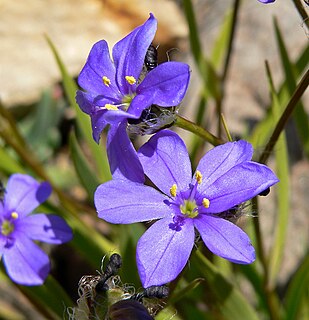
Aristea is a genus of evergreen, perennial and rhizomatous species of flowering plants in the family Iridaceae, first described in 1789. The genus is distributed in tropical and southern Africa, as well as Madagascar. The genus name is derived from the Greek word arista, meaning "awn".

Dactylorhiza foliosa, the Madeira orchid or leafy orchid, is a species of flowering plant in the family Orchidaceae, endemic to the Portuguese Island of Madeira in the eastern Atlantic Ocean. It is a tuberous herbaceous perennial growing to 60 cm (24 in) and producing spikes of intense, magenta-pink flowers in late spring.
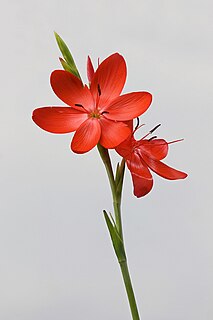
Hesperantha is a genus of cormous flowering plants in the family Iridaceae. The genus name is derived from the Greek words hesperos, meaning "evening", and anthos, meaning "flower".

Colchicum bulbocodium, the spring meadow saffron, is a species of alpine bulbous plant native to mountain ranges across Europe from the Pyrenees to the Caucasus.

Disa ferruginea is a stout, reed-like terrestrial 200–450 mm tall. Radical leaves linear, developing after flowering; cauline leaves dry, sheathing. Inflorescence dense, 1–40 flowered. Flowers bright red to orange, often with some parts yellow. Median sepal apiculate, galea 8–10 mm deep; spur slender, grading into the galea, 7–20 mm long; lateral sepals projecting away;elliptic to narrowly elliptic, with apiculi up to 4 mm long;petals spear-shaped, 5–7 mm long; lip narrowly egg- to spear-shaped, 10–12 mm long.
The anthophytes are a grouping of plant taxa bearing flower-like reproductive structures. They were formerly thought to be a clade comprising plants bearing flower-like structures. The group contained the angiosperms - the extant flowering plants, such as roses and grasses - as well as the Gnetales and the extinct Bennettitales.

Strumaria gemmata is a species of flowering plant in the family Amaryllidaceae, native to the Cape Provinces and the Free State of South Africa. It was first described by John Bellenden Ker Gawler in 1814.
